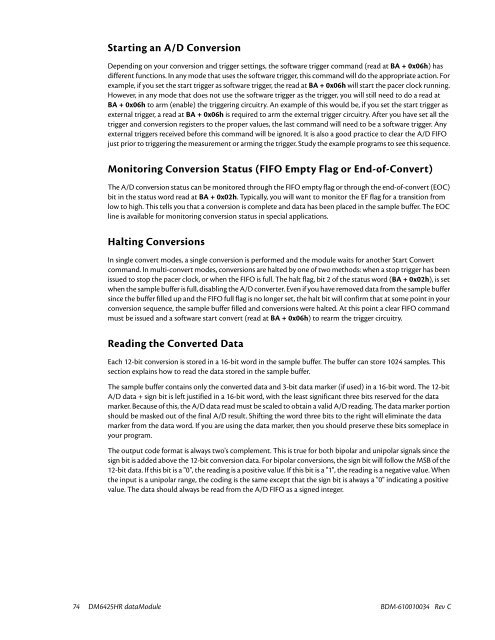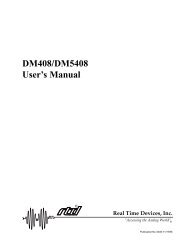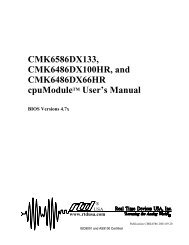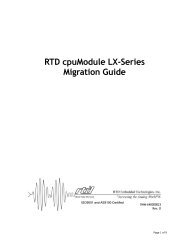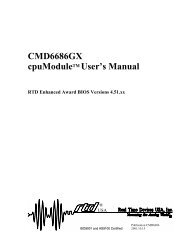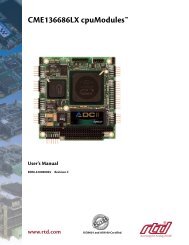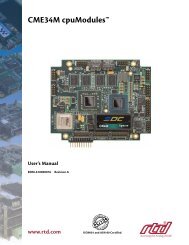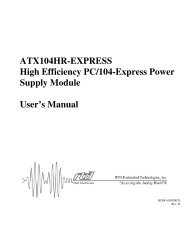Hardware Manual - RTD Embedded Technologies, Inc.
Hardware Manual - RTD Embedded Technologies, Inc.
Hardware Manual - RTD Embedded Technologies, Inc.
Create successful ePaper yourself
Turn your PDF publications into a flip-book with our unique Google optimized e-Paper software.
Starting an A/D Conversion<br />
Depending on your conversion and trigger settings, the software trigger command (read at BA + 0x06h) has<br />
different functions. In any mode that uses the software trigger, this command will do the appropriate action. For<br />
example, if you set the start trigger as software trigger, the read at BA + 0x06h will start the pacer clock running.<br />
However, in any mode that does not use the software trigger as the trigger, you will still need to do a read at<br />
BA + 0x06h to arm (enable) the triggering circuitry. An example of this would be, if you set the start trigger as<br />
external trigger, a read at BA + 0x06h is required to arm the external trigger circuitry. After you have set all the<br />
trigger and conversion registers to the proper values, the last command will need to be a software trigger. Any<br />
external triggers received before this command will be ignored. It is also a good practice to clear the A/D FIFO<br />
just prior to triggering the measurement or arming the trigger. Study the example programs to see this sequence.<br />
Monitoring Conversion Status (FIFO Empty Flag or End-of-Convert)<br />
The A/D conversion status can be monitored through the FIFO empty flag or through the end-of-convert (EOC)<br />
bit in the status word read at BA + 0x02h. Typically, you will want to monitor the EF flag for a transition from<br />
low to high. This tells you that a conversion is complete and data has been placed in the sample buffer. The EOC<br />
line is available for monitoring conversion status in special applications.<br />
Halting Conversions<br />
In single convert modes, a single conversion is performed and the module waits for another Start Convert<br />
command. In multi-convert modes, conversions are halted by one of two methods: when a stop trigger has been<br />
issued to stop the pacer clock, or when the FIFO is full. The halt flag, bit 2 of the status word (BA + 0x02h), is set<br />
when the sample buffer is full, disabling the A/D converter. Even if you have removed data from the sample buffer<br />
since the buffer filled up and the FIFO full flag is no longer set, the halt bit will confirm that at some point in your<br />
conversion sequence, the sample buffer filled and conversions were halted. At this point a clear FIFO command<br />
must be issued and a software start convert (read at BA + 0x06h) to rearm the trigger circuitry.<br />
Reading the Converted Data<br />
Each 12-bit conversion is stored in a 16-bit word in the sample buffer. The buffer can store 1024 samples. This<br />
section explains how to read the data stored in the sample buffer.<br />
The sample buffer contains only the converted data and 3-bit data marker (if used) in a 16-bit word. The 12-bit<br />
A/D data + sign bit is left justified in a 16-bit word, with the least significant three bits reserved for the data<br />
marker. Because of this, the A/D data read must be scaled to obtain a valid A/D reading. The data marker portion<br />
should be masked out of the final A/D result. Shifting the word three bits to the right will eliminate the data<br />
marker from the data word. If you are using the data marker, then you should preserve these bits someplace in<br />
your program.<br />
The output code format is always two's complement. This is true for both bipolar and unipolar signals since the<br />
sign bit is added above the 12-bit conversion data. For bipolar conversions, the sign bit will follow the MSB of the<br />
12-bit data. If this bit is a "0", the reading is a positive value. If this bit is a "1", the reading is a negative value. When<br />
the input is a unipolar range, the coding is the same except that the sign bit is always a "0" indicating a positive<br />
value. The data should always be read from the A/D FIFO as a signed integer.<br />
74 DM6425HR dataModule BDM-610010034 Rev C


